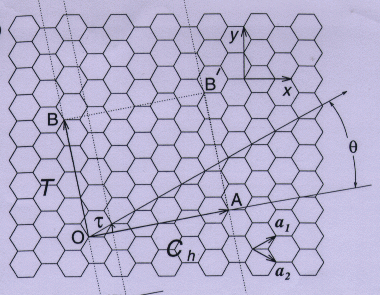![]()

Figure 1. Primitive vectors of a graphite sheet.
The x axis is commonly called armchair and the y axis
is called zigzag [10].
Background on carbon nanotubes
Carbon nanotubes are a set of novel materials which aroused great interest in recent years due to their exceptional mechanical and electrical properties. The Carbon nanotube is the forth stable structure of carbon after diamond and graphite and fullerene. These can be seen as a result of the folding of graphite sheets into a tube. Studying the mechanical properties of carbon nanotubes might be of relevance both theoretically and technologically. Actually, carbon nanotubes are considered an important potential material for strong fibers and scanning probe microscope tips.
Because the carbons bonds in graphite are planar sp2 bonds,
the energy of carbon nanotubes is higher than for graphite due to the distortion
of these sp2 orbitals. It can be easily understood that there are many
ways to fold the graphite sheets into nanotubes which gives them a wide
range of radius and of orientation.
Nomenclature of carbon nanotubes
The nomenclature of carbon nanotubes are characterized by a pair of integer [n,m]. These integers define the orientation and the diameter of a nanotube.
The integers refer to the chiral vector Ch of the tube, which is given in term of the primitive vectors of the graphite sheet (see figure below) :
![]()

Figure 1. Primitive vectors of a graphite sheet.
The x axis is commonly called armchair and the y axis
is called zigzag [10].
The length of the chiral vector defines the circumference of the tube, it is given by :

with a=equilibrium distance of the carbon bond (1.42 for graphite). This chiral vector length defines the circumference of the tube.
The orientation of the tube is given by the angle theta :

Basically, each pair of integers can be associated with
a way of folding the graphite sheet to a nanotube. Theses nanotubes can
have a "straigth orientation or a "screwed orientation".
Here is some examples of straigth
[10,10] nanotubes and screwed [18,12] nanotubes.
Computer simulations and experiments on carbon nanotubes
As studies have shown, the behavior of single wall and multi-wall carbon nanotubes can be probed by molecular dynamics. The non-bonded interactions between walls could be modeled using a Lennard-Jones potential [5,6].
Although no simulations has been done on the motion of
concentric nanotubes, studies has been made on the motion of nanotubes
on a (graphite) substrate. Lennard-Jones potential is used in the simulation
of carbon nanotubes on graphite substrate. The potential energy of the
tube is found to depend on its mis-orientation with the substrate and the
chirality of the tube [7]. Sliding and rolling motions have been found
in the simulations, resulting from the application of a force to the system.
Competition between the two motions is related to the potential energy
barrier of the system. Although the potential used in the simulation is
simple, the simulation results are found to be consistent with experimental
results.

